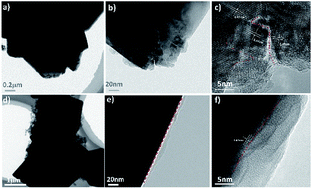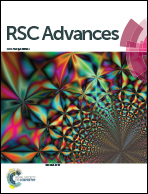Effectively enhanced structural stability and electrochemical properties of LiNi0.5Mn1.5O4 cathode materials via poly-(3,4-ethylenedioxythiophene)-in situ coated for high voltage Li-ion batteries†
Abstract
Spinel LiNi0.5Mn1.5O4 shows promise as a potential candidate for Li-ion batteries due to its high energy density and high rate performance. However, LiNi0.5Mn1.5O4 (LNMO) spinel oxides usually deliver poor cycle life because of the increasing impedance and gradually dissolving Mn resulting in the destruction of crystal structure. Here, a conductive polymer poly-(3,4-ethylenedioxythiophene) (PEDOT) surface modified strategy is introduced to settle the above challenges. The main purpose is to construct a uniform and dense shell film on the surface of LiNi0.5Mn1.5O4 (Industrial Grade), which is prepared by a simple chemical in situ oxidative polymerization method. The Mn dissolving from the lattice during the long-term cycling is well inhibited as the polymer shell protects LiNi0.5Mn1.5O4 from direct exposure to the highly active electrolyte. As expected, the 3 wt% poly-(3,4-ethylenedioxythiophene) coated sample reveals long cycle life with acceptable capacity of 114.5 mA h g−1 and high capacity retention of 91.6% after 200 cycles, compared to 70.9 mA h g−1 and 56.5%, respectively, for the bare LiNi0.5Mn1.5O4 sample. Furthermore, the coated sample demonstrates a higher capacity of 110 mA h g−1 and 63 mA h g−1 at 5C and 10C rate respectively. The improved performance is believed to be attributed to the formation of high conductivity and stable interface structure between electrolyte and LNMO, which is beneficial to suppress the destruction of crystalline structure due to the Mn dissolution and undesired side-reaction between electrolyte and LiNi0.5Mn1.5O4 in long cycle, and improve simultaneously the conductivity and interface stability of LiNi0.5Mn1.5O4 for high voltage lithium-ion batteries.



 Please wait while we load your content...
Please wait while we load your content...